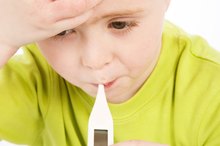Signs of Intermittent Fever in Children
When your child has a fever, it means his body has raised its temperature to fight a condition or infection 2. Even though it helps the body heal, you’ll probably worry; and chances are, if he repeatedly gets that fever when you think he’s getting better, you may worry even more 2. Intermittent fever, or periodic fever, is often a symptom of more serious diseases and conditions 2. Learning the signs of intermittent fever in children will help you decide when to take your child to his doctor for further evaluation 12.
Temperature
With intermittent fever, your child will periodically have an elevated temperature of over 38 degrees Celsius, or 100.4 degrees Fahrenheit 2. After the period of high temperature, it will return to normal for a time.
Periodicity
My Baby Has a Fever & Red Dots All Over
Learn More
How often and how long your child has a fever, and how much the temperature fluctuates, tells you whether or not it’s intermittent 2. A continuous fever keeps a constant temperature over a 24-hour period, not fluctuating more than 1 degree Celsius (or 1.8 degrees Fahrenheit) 2. If your child has remittent fever, her temperature will fluctuate more than 2 degrees Celsius (or 3.6 degrees Fahrenheit) each day, returning to a baseline temperature between each episode, but not quite to normal 2.
Intermittent fever, however, is slightly more complicated 2. In this case, your child’s fever will only persist for a few hours at a time, and then return to normal 2. If it comes back every day, it’s called Quotidian fever; every other day, it’s called Tertian fever; and if it only comes once every three days, it’s called Quartan fever 2. With certain diseases, the fever may even disappear for a week or more before returning 2.
Vital Signs
When the body’s core temperature rises, it affects the vital signs, so you may observe other changes as well. Your child’s heart rate will increase by 10 beats per minute for every degree Fahrenheit, above 100, that his temperature goes up. It’s normal for his blood pressure and rate of breathing to also increase during this time.
Conditions
Is a Kid Still Sick When a Fever Breaks?
Learn More
If your child has intermittent fever, it could very well mean that he has a more serious condition or disease, and the periodic fever is just a symptom of it 2. One disease marked by intermittent fever is PFAPA Syndrome, or Marshall’s Syndrome, which is most often found in children under 5, and is characterized by fever that returns every 3 to 4 weeks 12. Malaria is usually accompanied by fever that returns every second to third day, and Rat Bite Fever’s periodic fever happens every 3 to 5 days 2. Cyclic Neutropenia, also called Schultz’s Disease, comes with fever every three weeks 2. Hodgkin’s Disease also has a symptom of intermittent fever, but it’s rare in kids under 5 years old 2.
Related Articles
References
Writer Bio
Heather Vale is a writer, interviewer and seasoned journalist. She has authored news, entertainment and informational programming in TV, radio, print and online media. She is also a certified childhood fitness and nutrition specialist with a background in mind-body-spirit health, self-help, business, technology and pet breeding. Vale holds a Bachelor of Fine Arts in visual arts from York University.









